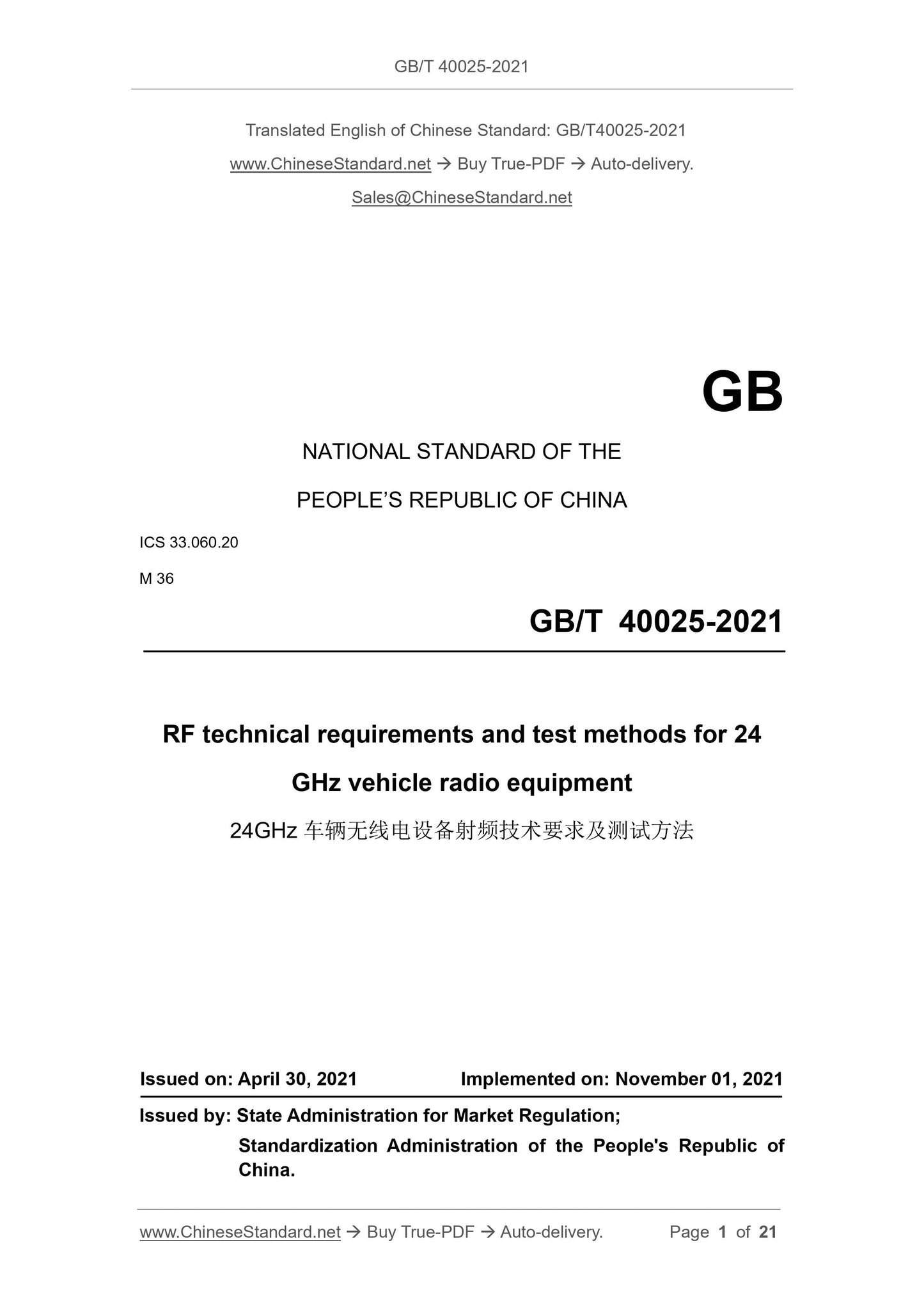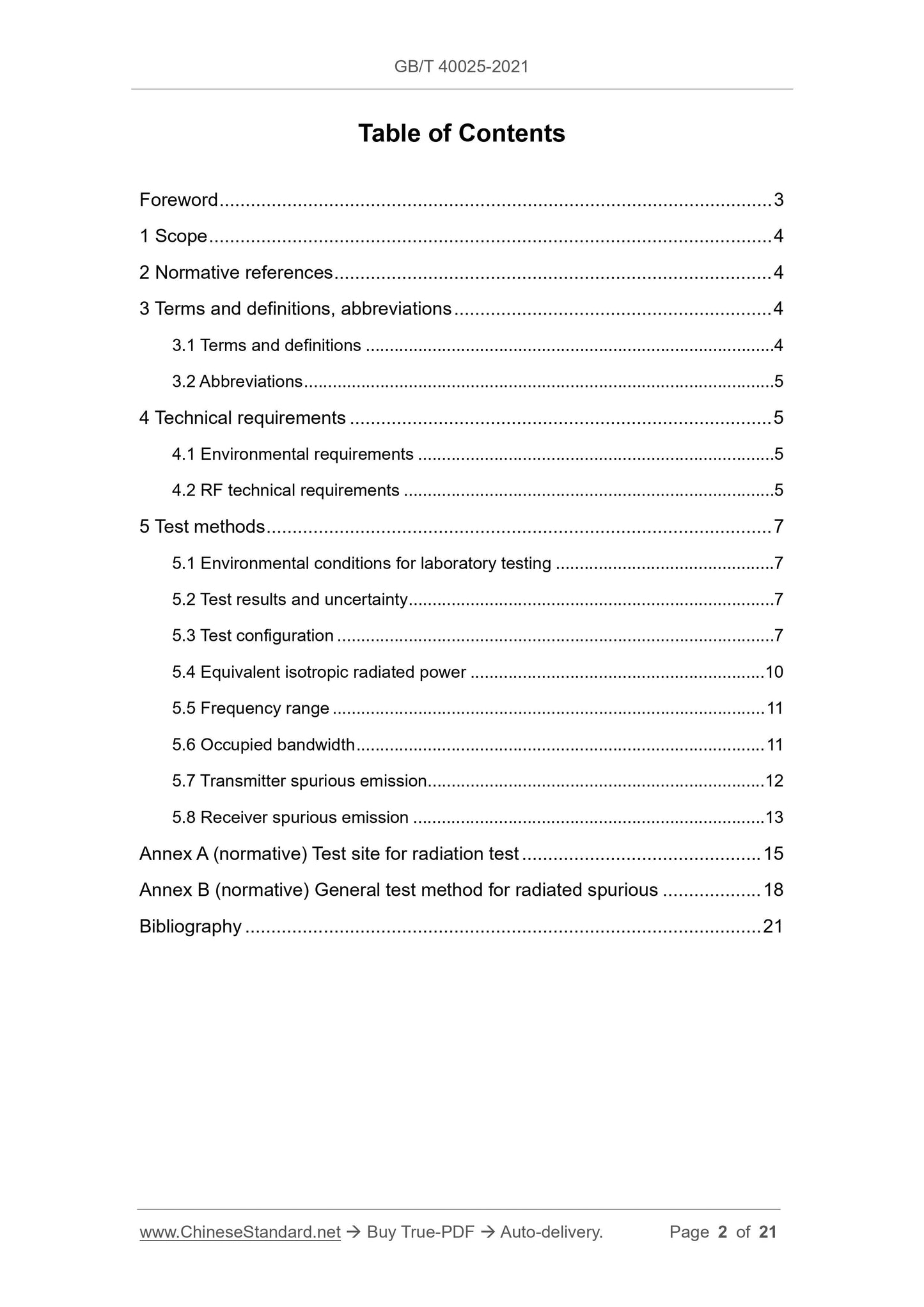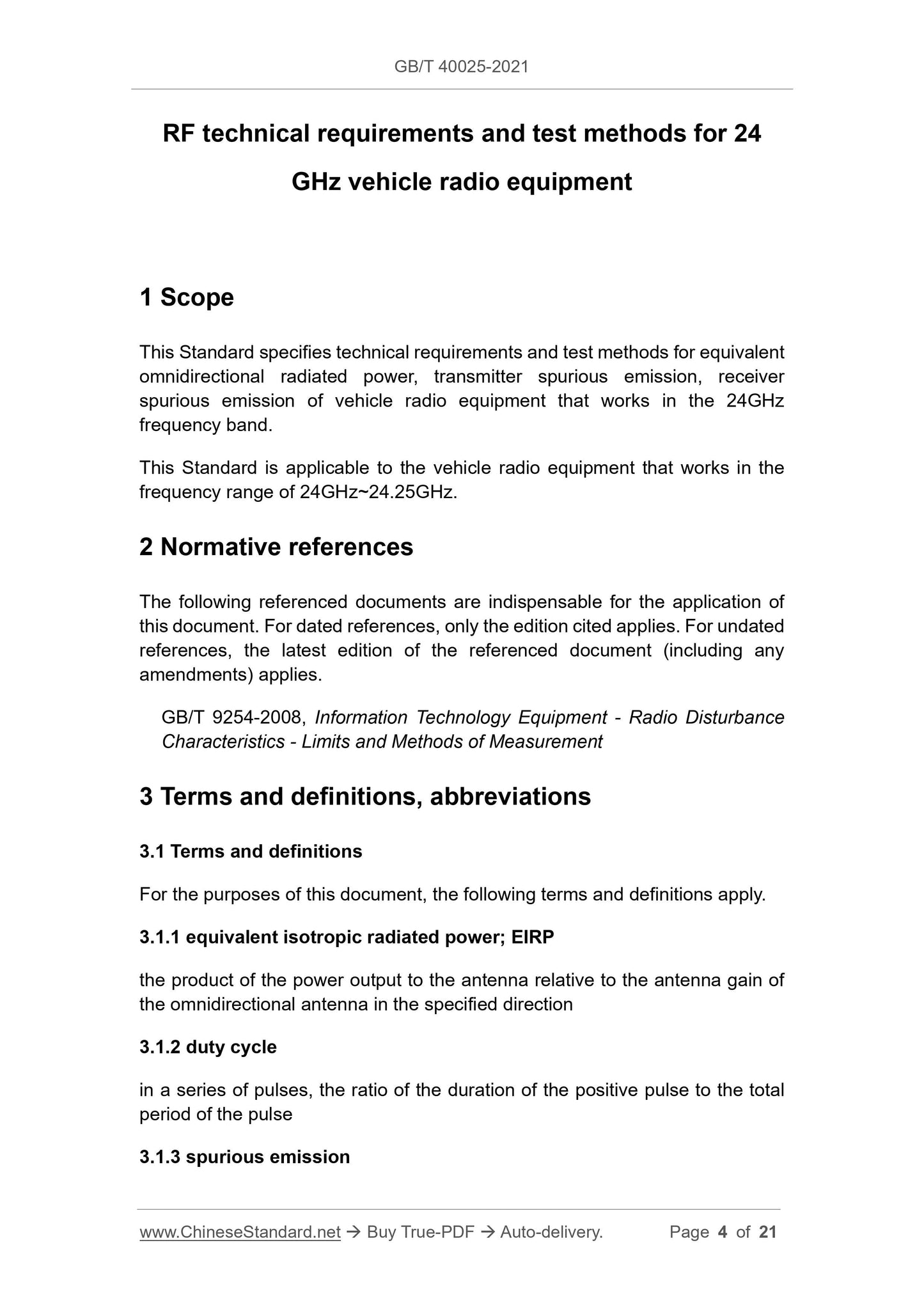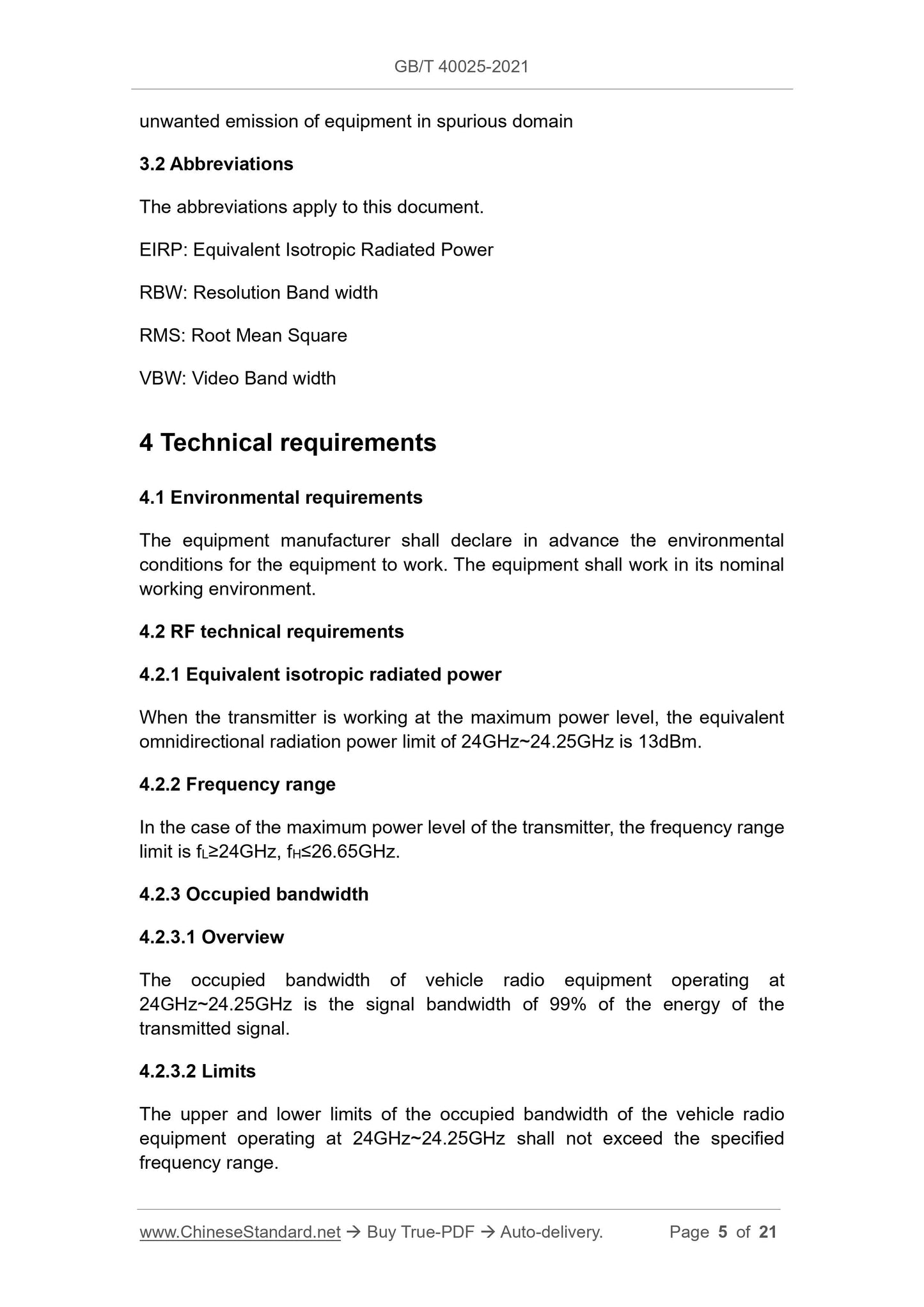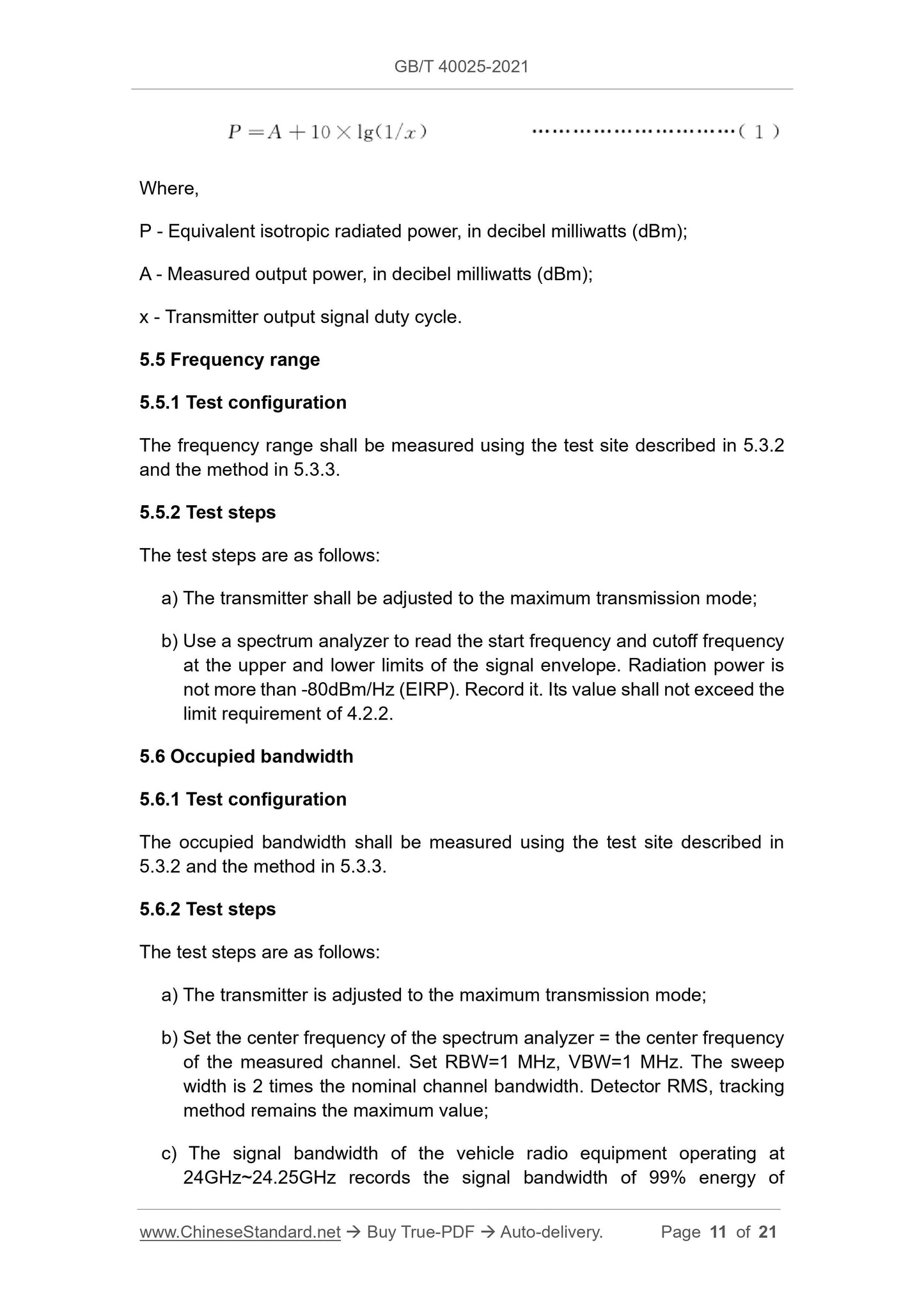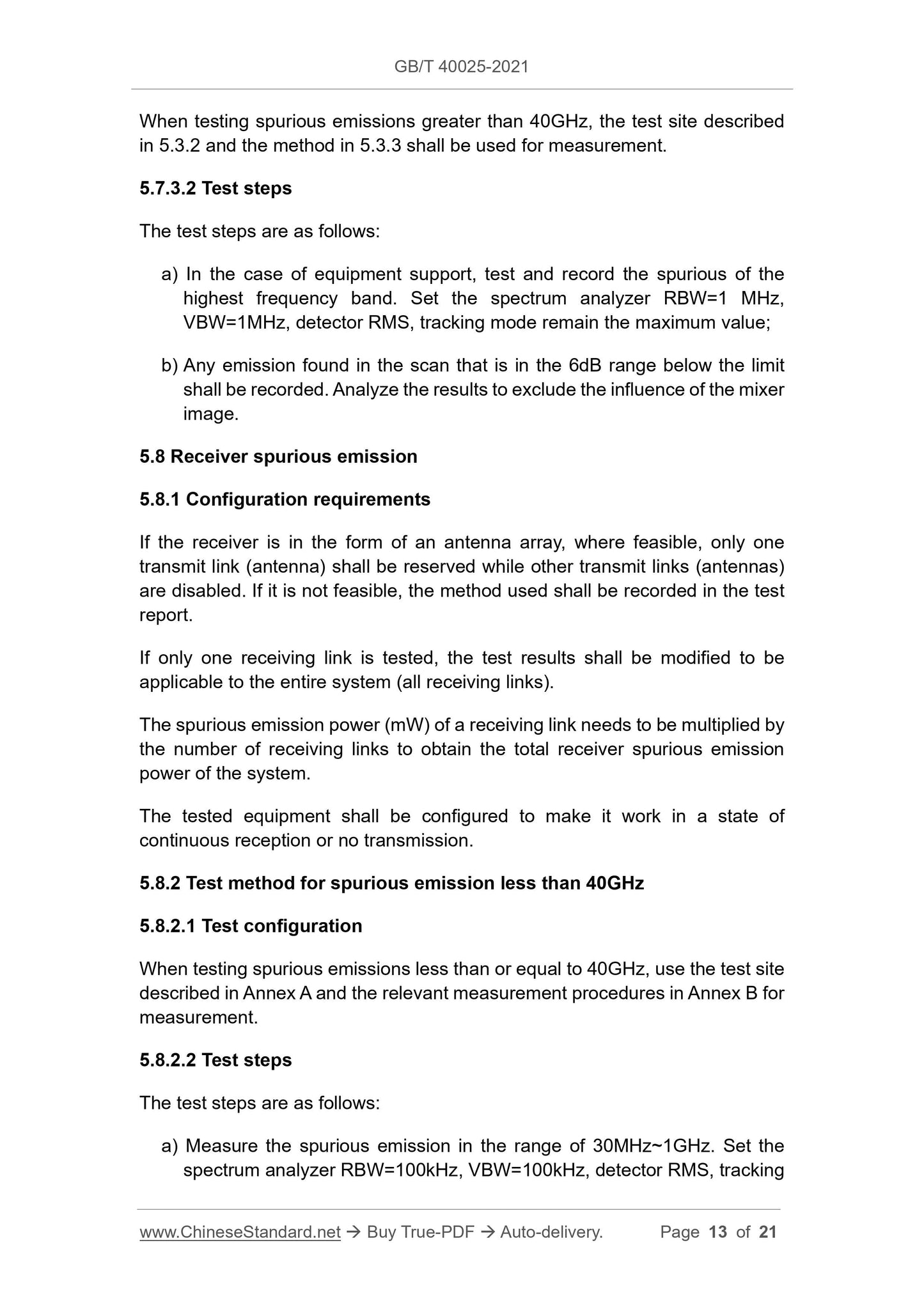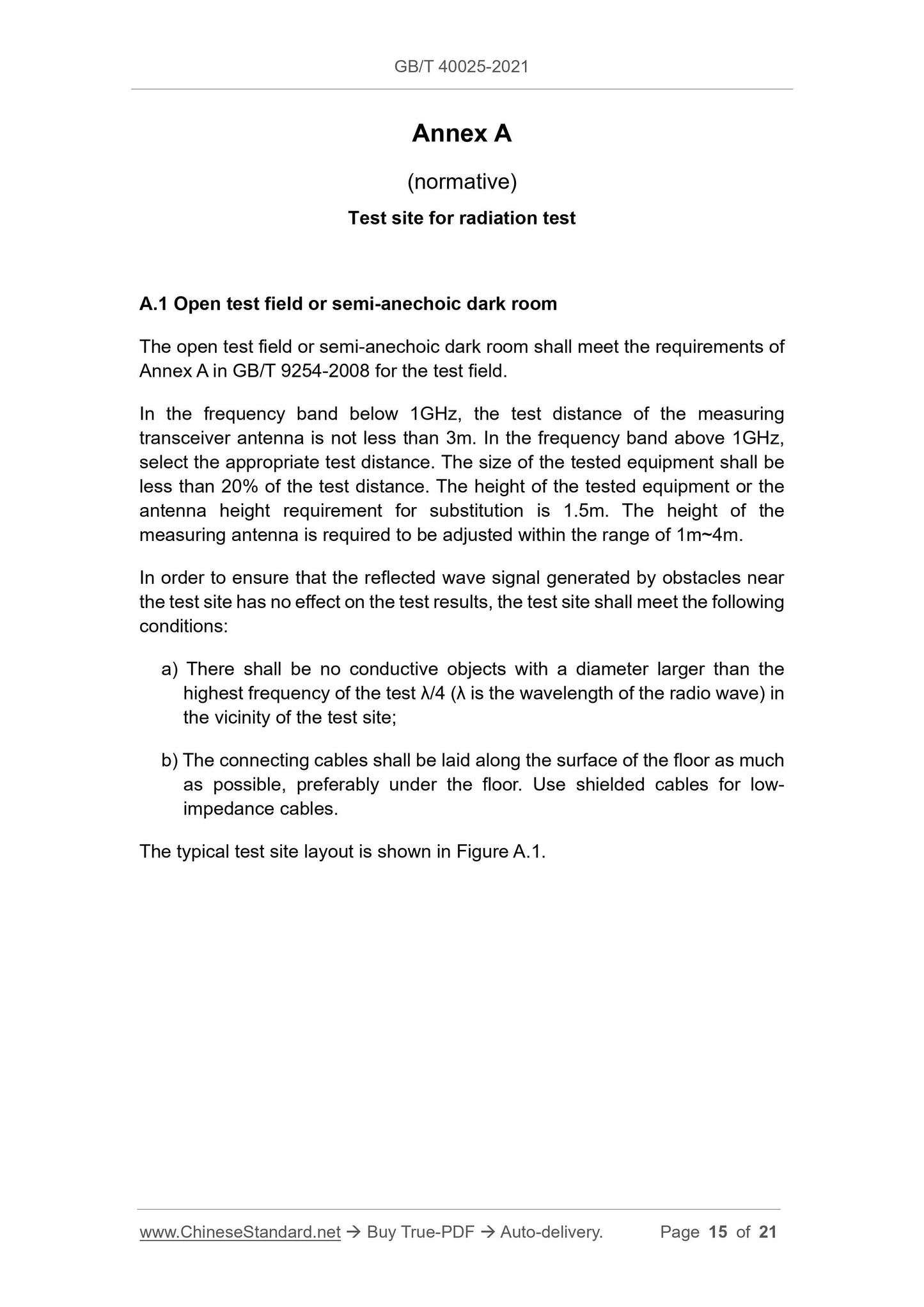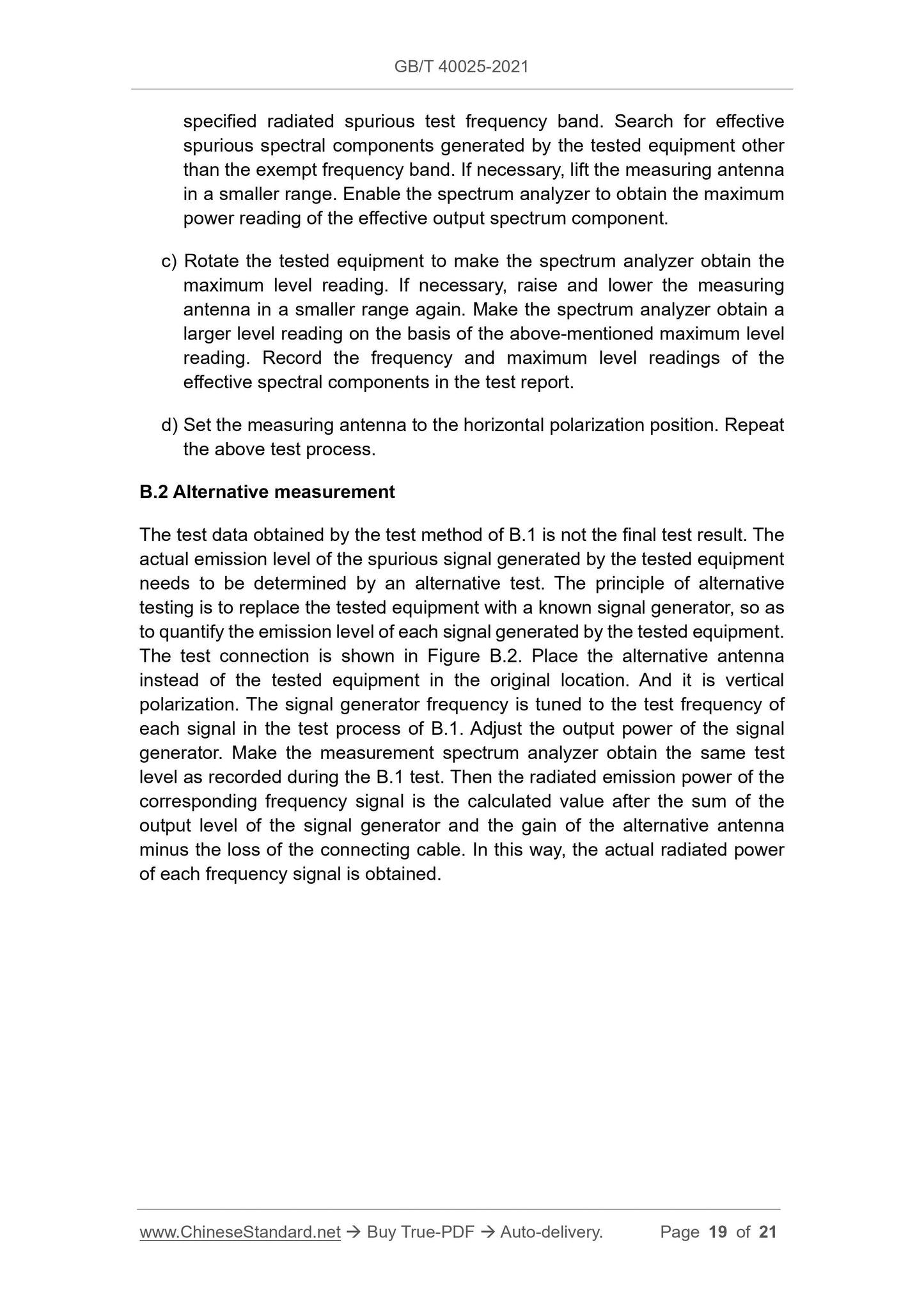1
/
of
8
www.ChineseStandard.us -- Field Test Asia Pte. Ltd.
GB/T 40025-2021 English PDF (GB/T40025-2021)
GB/T 40025-2021 English PDF (GB/T40025-2021)
Regular price
$285.00
Regular price
Sale price
$285.00
Unit price
/
per
Shipping calculated at checkout.
Couldn't load pickup availability
GB/T 40025-2021: RF technical requirements and test methods for 24 GHz vehicle radio equipment
Delivery: 9 seconds. Download (& Email) true-PDF + Invoice.
Get Quotation: Click GB/T 40025-2021 (Self-service in 1-minute)
Historical versions (Master-website): GB/T 40025-2021
Preview True-PDF (Reload/Scroll-down if blank)
GB/T 40025-2021
GB
NATIONAL STANDARD OF THE
PEOPLE’S REPUBLIC OF CHINA
ICS 33.060.20
M 36
RF technical requirements and test methods for 24
GHz vehicle radio equipment
ISSUED ON: APRIL 30, 2021
IMPLEMENTED ON: NOVEMBER 01, 2021
Issued by: State Administration for Market Regulation;
Standardization Administration of the People's Republic of
China.
Table of Contents
Foreword ... 3
1 Scope ... 4
2 Normative references ... 4
3 Terms and definitions, abbreviations ... 4
3.1 Terms and definitions ... 4
3.2 Abbreviations ... 5
4 Technical requirements ... 5
4.1 Environmental requirements ... 5
4.2 RF technical requirements ... 5
5 Test methods ... 7
5.1 Environmental conditions for laboratory testing ... 7
5.2 Test results and uncertainty ... 7
5.3 Test configuration ... 7
5.4 Equivalent isotropic radiated power ... 10
5.5 Frequency range ... 11
5.6 Occupied bandwidth ... 11
5.7 Transmitter spurious emission ... 12
5.8 Receiver spurious emission ... 13
Annex A (normative) Test site for radiation test ... 15
Annex B (normative) General test method for radiated spurious ... 18
Bibliography ... 21
RF technical requirements and test methods for 24
GHz vehicle radio equipment
1 Scope
This Standard specifies technical requirements and test methods for equivalent
omnidirectional radiated power, transmitter spurious emission, receiver
spurious emission of vehicle radio equipment that works in the 24GHz
frequency band.
This Standard is applicable to the vehicle radio equipment that works in the
frequency range of 24GHz~24.25GHz.
2 Normative references
The following referenced documents are indispensable for the application of
this document. For dated references, only the edition cited applies. For undated
references, the latest edition of the referenced document (including any
amendments) applies.
GB/T 9254-2008, Information Technology Equipment - Radio Disturbance
Characteristics - Limits and Methods of Measurement
3 Terms and definitions, abbreviations
3.1 Terms and definitions
For the purposes of this document, the following terms and definitions apply.
3.1.1 equivalent isotropic radiated power; EIRP
the product of the power output to the antenna relative to the antenna gain of
the omnidirectional antenna in the specified direction
3.1.2 duty cycle
in a series of pulses, the ratio of the duration of the positive pulse to the total
period of the pulse
3.1.3 spurious emission
unwanted emission of equipment in spurious domain
3.2 Abbreviations
The abbreviations apply to this document.
EIRP: Equivalent Isotropic Radiated Power
RBW: Resolution Band width
RMS: Root Mean Square
VBW: Video Band width
4 Technical requirements
4.1 Environmental requirements
The equipment manufacturer shall declare in advance the environmental
conditions for the equipment to work. The equipment shall work in its nominal
working environment.
4.2 RF technical requirements
4.2.1 Equivalent isotropic radiated power
When the transmitter is working at the maximum power level, the equivalent
omnidirectional radiation power limit of 24GHz~24.25GHz is 13dBm.
4.2.2 Frequency range
In the case of the maximum power level of the transmitter, the frequency range
limit is fL≥24GHz, fH≤26.65GHz.
4.2.3 Occupied bandwidth
4.2.3.1 Overview
The occupied bandwidth of vehicle radio equipment operating at
24GHz~24.25GHz is the signal bandwidth of 99% of the energy of the
transmitted signal.
4.2.3.2 Limits
The upper and lower limits of the occupied bandwidth of the vehicle radio
equipment operating at 24GHz~24.25GHz shall not exceed the specified
frequency range.
Where,
P - Equivalent isotropic radiated power, in decibel milliwatts (dBm);
A - Measured output power, in decibel milliwatts (dBm);
x - Transmitter output signal duty cycle.
5.5 Frequency range
5.5.1 Test configuration
The frequency range shall be measured using the test site described in 5.3.2
and the method in 5.3.3.
5.5.2 Test steps
The test steps are as follows:
a) The transmitter shall be adjusted to the maximum transmission mode;
b) Use a spectrum analyzer to read the start frequency and cutoff frequency
at the upper and lower limits of the signal envelope. Radiation power is
not more than -80dBm/Hz (EIRP). Record it. Its value shall not exceed the
limit requirement of 4.2.2.
5.6 Occupied bandwidth
5.6.1 Test configuration
The occupied bandwidth shall be measured using the test site described in
5.3.2 and the method in 5.3.3.
5.6.2 Test steps
The test steps are as follows:
a) The transmitter is adjusted to the maximum transmission mode;
b) Set the center frequency of the spectrum analyzer = the center frequency
of the measured channel. Set RBW=1 MHz, VBW=1 MHz. The sweep
width is 2 times the nominal channel bandwidth. Detector RMS, tracking
method remains the maximum value;
c) The signal bandwidth of the vehicle radio equipment operating at
24GHz~24.25GHz records the signal bandwidth of 99% energy of
When testing spurious emissions greater than 40GHz, the test site described
in 5.3.2 and the method in 5.3.3 shall be used for measurement.
5.7.3.2 Test steps
The test steps are as follows:
a) In the case of equipment support, test and record the spurious of the
highest frequency band. Set the spectrum analyzer RBW=1 MHz,
VBW=1MHz, detector RMS, tracking mode remain the maximum value;
b) Any emission found in the scan that is in the 6dB range below the limit
shall be recorded. Analyze the results to exclude the influence of the mixer
image.
5.8 Receiver spurious emission
5.8.1 Configuration requirements
If the receiver is in the form of an antenna array, where feasible, only one
transmit link (antenna) shall be reserved while other transmit links (antennas)
are disabled. If it is not feasible, the method used shall be recorded in the test
report.
If only one receiving link is tested, the test results shall be modified to be
applicable to the entire system (all receiving links).
The spurious emission power (mW) of a receiving link needs to be multiplied by
the number of receiving links to obtain the total receiver spurious emission
power of the system.
The tested equipment shall be configured to make it work in a state of
continuous reception or no transmission.
5.8.2 Test method for spurious emission less than 40GHz
5.8.2.1 Test configuration
When testing spurious emissions less than or equal to 40GHz, use the test site
described in Annex A and the relevant measurement procedures in Annex B for
measurement.
5.8.2.2 Test steps
The test steps are as follows:
a) Measure the spurious emission in the range of 30MHz~1GHz. Set the
spectrum analyzer RBW=100kHz, VBW=100kHz, detector RMS, tracking
Annex A
(normative)
Test site for radiation test
A.1 Open test field or semi-anechoic dark room
The open test field or semi-anechoic dark room shall meet the requirements of
Annex A in GB/T 9254-2008 for the test field.
In the frequency band below 1GHz, the test distance of the measuring
transceiver antenna is not less than 3m. In the frequency band above 1GHz,
select the appropriate test distance. The size of the tested equipment shall be
less than 20% of the test distance. The height of the tested equipment or the
antenna height requirement for substitution is 1.5m. The height of the
measuring antenna is required to be adjusted within the range of 1m~4m.
In order to ensure that the reflected wave signal generated by obstacles near
the test site has no effect on the test results, the test site shall meet the following
conditions:
a) There shall be no conductive objects with a diameter larger than the
highest frequency of the test λ/4 (λ is the wavelength of the radio wave) in
the vicinity of the test site;
b) The connecting cables shall be laid along the surface of the floor as much
as possible, preferably under the floor. Use shielded cables for low-
impedance cables.
The typical test site layout is shown in Figure A.1.
specified radiated spurious test frequency band. Search for effective
spurious spectral components generated by the tested equipment other
than the exempt frequency band. If necessary, lift the measuring antenna
in a smaller range. Enable the spectrum analyzer to obtain the maximum
power reading of the effective output spectrum component.
c) Rotate the tested equipment to make the spectrum analyzer obtain the
maximum level reading. If necessary, raise and lower the measuring
antenna in a smaller range again. Make the spectrum analyzer obtain a
larger level reading on the basis of the above-mentioned maximum level
reading. Record the frequency and maximum level readings of the
effective spectral components in the test report.
d) Set the measuring antenna to the horizontal polarization position. Repeat
the above test process.
B.2 Alternative measurement
The test data obtained by the test method of B.1 is not the final test result. The
actual emission level of the spurious signal generated by the tested equipment
needs to be determined by an alternative test. The principle of alternative
testing is to replace the tested equipment with a known signal generator, so as
to quantify the emission level of each signal generated by the tested equipment.
The test connection is shown in Figure B.2. Place the alternative antenna
instead of the tested equipment in the original location. And it is vertical
polarization. The signal generator frequency is tuned to the test frequency of
each signal in the test process of B.1. Adjust the output power of the signal
generator. Make the measurement spectrum analyzer obtain the same test
level as recorded during the B.1 test. Then the radiated emission power of the
corresponding frequency signal is the calculated value after the sum of the
output level of the signal generator and the gain of the alternative antenna
minus the loss of the connecting cable. In this way, the actual radiated power
of each frequency signal is obtained.
GB/T 40025-2021
GB
NATIONAL STANDARD OF THE
PEOPLE’S REPUBLIC OF CHINA
ICS 33.060.20
M 36
RF technical requirements and test methods for 24
GHz vehicle radio equipment
ISSUED ON: APRIL 30, 2021
IMPLEMENTED ON: NOVEMBER 01, 2021
Issued by: State Administration for Market Regulation;
Standardization Administration of the People's Republic of
China.
Table of Contents
Foreword ... 3
1 Scope ... 4
2 Normative references ... 4
3 Terms and definitions, abbreviations ... 4
3.1 Terms and definitions ... 4
3.2 Abbreviations ... 5
4 Technical requirements ... 5
4.1 Environmental requirements ... 5
4.2 RF technical requirements ... 5
5 Test methods ... 7
5.1 Environmental conditions for laboratory testing ... 7
5.2 Test results and uncertainty ... 7
5.3 Test configuration ... 7
5.4 Equivalent isotropic radiated power ... 10
5.5 Frequency range ... 11
5.6 Occupied bandwidth ... 11
5.7 Transmitter spurious emission ... 12
5.8 Receiver spurious emission ... 13
Annex A (normative) Test site for radiation test ... 15
Annex B (normative) General test method for radiated spurious ... 18
Bibliography ... 21
RF technical requirements and test methods for 24
GHz vehicle radio equipment
1 Scope
This Standard specifies technical requirements and test methods for equivalent
omnidirectional radiated power, transmitter spurious emission, receiver
spurious emission of vehicle radio equipment that works in the 24GHz
frequency band.
This Standard is applicable to the vehicle radio equipment that works in the
frequency range of 24GHz~24.25GHz.
2 Normative references
The following referenced documents are indispensable for the application of
this document. For dated references, only the edition cited applies. For undated
references, the latest edition of the referenced document (including any
amendments) applies.
GB/T 9254-2008, Information Technology Equipment - Radio Disturbance
Characteristics - Limits and Methods of Measurement
3 Terms and definitions, abbreviations
3.1 Terms and definitions
For the purposes of this document, the following terms and definitions apply.
3.1.1 equivalent isotropic radiated power; EIRP
the product of the power output to the antenna relative to the antenna gain of
the omnidirectional antenna in the specified direction
3.1.2 duty cycle
in a series of pulses, the ratio of the duration of the positive pulse to the total
period of the pulse
3.1.3 spurious emission
unwanted emission of equipment in spurious domain
3.2 Abbreviations
The abbreviations apply to this document.
EIRP: Equivalent Isotropic Radiated Power
RBW: Resolution Band width
RMS: Root Mean Square
VBW: Video Band width
4 Technical requirements
4.1 Environmental requirements
The equipment manufacturer shall declare in advance the environmental
conditions for the equipment to work. The equipment shall work in its nominal
working environment.
4.2 RF technical requirements
4.2.1 Equivalent isotropic radiated power
When the transmitter is working at the maximum power level, the equivalent
omnidirectional radiation power limit of 24GHz~24.25GHz is 13dBm.
4.2.2 Frequency range
In the case of the maximum power level of the transmitter, the frequency range
limit is fL≥24GHz, fH≤26.65GHz.
4.2.3 Occupied bandwidth
4.2.3.1 Overview
The occupied bandwidth of vehicle radio equipment operating at
24GHz~24.25GHz is the signal bandwidth of 99% of the energy of the
transmitted signal.
4.2.3.2 Limits
The upper and lower limits of the occupied bandwidth of the vehicle radio
equipment operating at 24GHz~24.25GHz shall not exceed the specified
frequency range.
Where,
P - Equivalent isotropic radiated power, in decibel milliwatts (dBm);
A - Measured outp...
Delivery: 9 seconds. Download (& Email) true-PDF + Invoice.
Get Quotation: Click GB/T 40025-2021 (Self-service in 1-minute)
Historical versions (Master-website): GB/T 40025-2021
Preview True-PDF (Reload/Scroll-down if blank)
GB/T 40025-2021
GB
NATIONAL STANDARD OF THE
PEOPLE’S REPUBLIC OF CHINA
ICS 33.060.20
M 36
RF technical requirements and test methods for 24
GHz vehicle radio equipment
ISSUED ON: APRIL 30, 2021
IMPLEMENTED ON: NOVEMBER 01, 2021
Issued by: State Administration for Market Regulation;
Standardization Administration of the People's Republic of
China.
Table of Contents
Foreword ... 3
1 Scope ... 4
2 Normative references ... 4
3 Terms and definitions, abbreviations ... 4
3.1 Terms and definitions ... 4
3.2 Abbreviations ... 5
4 Technical requirements ... 5
4.1 Environmental requirements ... 5
4.2 RF technical requirements ... 5
5 Test methods ... 7
5.1 Environmental conditions for laboratory testing ... 7
5.2 Test results and uncertainty ... 7
5.3 Test configuration ... 7
5.4 Equivalent isotropic radiated power ... 10
5.5 Frequency range ... 11
5.6 Occupied bandwidth ... 11
5.7 Transmitter spurious emission ... 12
5.8 Receiver spurious emission ... 13
Annex A (normative) Test site for radiation test ... 15
Annex B (normative) General test method for radiated spurious ... 18
Bibliography ... 21
RF technical requirements and test methods for 24
GHz vehicle radio equipment
1 Scope
This Standard specifies technical requirements and test methods for equivalent
omnidirectional radiated power, transmitter spurious emission, receiver
spurious emission of vehicle radio equipment that works in the 24GHz
frequency band.
This Standard is applicable to the vehicle radio equipment that works in the
frequency range of 24GHz~24.25GHz.
2 Normative references
The following referenced documents are indispensable for the application of
this document. For dated references, only the edition cited applies. For undated
references, the latest edition of the referenced document (including any
amendments) applies.
GB/T 9254-2008, Information Technology Equipment - Radio Disturbance
Characteristics - Limits and Methods of Measurement
3 Terms and definitions, abbreviations
3.1 Terms and definitions
For the purposes of this document, the following terms and definitions apply.
3.1.1 equivalent isotropic radiated power; EIRP
the product of the power output to the antenna relative to the antenna gain of
the omnidirectional antenna in the specified direction
3.1.2 duty cycle
in a series of pulses, the ratio of the duration of the positive pulse to the total
period of the pulse
3.1.3 spurious emission
unwanted emission of equipment in spurious domain
3.2 Abbreviations
The abbreviations apply to this document.
EIRP: Equivalent Isotropic Radiated Power
RBW: Resolution Band width
RMS: Root Mean Square
VBW: Video Band width
4 Technical requirements
4.1 Environmental requirements
The equipment manufacturer shall declare in advance the environmental
conditions for the equipment to work. The equipment shall work in its nominal
working environment.
4.2 RF technical requirements
4.2.1 Equivalent isotropic radiated power
When the transmitter is working at the maximum power level, the equivalent
omnidirectional radiation power limit of 24GHz~24.25GHz is 13dBm.
4.2.2 Frequency range
In the case of the maximum power level of the transmitter, the frequency range
limit is fL≥24GHz, fH≤26.65GHz.
4.2.3 Occupied bandwidth
4.2.3.1 Overview
The occupied bandwidth of vehicle radio equipment operating at
24GHz~24.25GHz is the signal bandwidth of 99% of the energy of the
transmitted signal.
4.2.3.2 Limits
The upper and lower limits of the occupied bandwidth of the vehicle radio
equipment operating at 24GHz~24.25GHz shall not exceed the specified
frequency range.
Where,
P - Equivalent isotropic radiated power, in decibel milliwatts (dBm);
A - Measured output power, in decibel milliwatts (dBm);
x - Transmitter output signal duty cycle.
5.5 Frequency range
5.5.1 Test configuration
The frequency range shall be measured using the test site described in 5.3.2
and the method in 5.3.3.
5.5.2 Test steps
The test steps are as follows:
a) The transmitter shall be adjusted to the maximum transmission mode;
b) Use a spectrum analyzer to read the start frequency and cutoff frequency
at the upper and lower limits of the signal envelope. Radiation power is
not more than -80dBm/Hz (EIRP). Record it. Its value shall not exceed the
limit requirement of 4.2.2.
5.6 Occupied bandwidth
5.6.1 Test configuration
The occupied bandwidth shall be measured using the test site described in
5.3.2 and the method in 5.3.3.
5.6.2 Test steps
The test steps are as follows:
a) The transmitter is adjusted to the maximum transmission mode;
b) Set the center frequency of the spectrum analyzer = the center frequency
of the measured channel. Set RBW=1 MHz, VBW=1 MHz. The sweep
width is 2 times the nominal channel bandwidth. Detector RMS, tracking
method remains the maximum value;
c) The signal bandwidth of the vehicle radio equipment operating at
24GHz~24.25GHz records the signal bandwidth of 99% energy of
When testing spurious emissions greater than 40GHz, the test site described
in 5.3.2 and the method in 5.3.3 shall be used for measurement.
5.7.3.2 Test steps
The test steps are as follows:
a) In the case of equipment support, test and record the spurious of the
highest frequency band. Set the spectrum analyzer RBW=1 MHz,
VBW=1MHz, detector RMS, tracking mode remain the maximum value;
b) Any emission found in the scan that is in the 6dB range below the limit
shall be recorded. Analyze the results to exclude the influence of the mixer
image.
5.8 Receiver spurious emission
5.8.1 Configuration requirements
If the receiver is in the form of an antenna array, where feasible, only one
transmit link (antenna) shall be reserved while other transmit links (antennas)
are disabled. If it is not feasible, the method used shall be recorded in the test
report.
If only one receiving link is tested, the test results shall be modified to be
applicable to the entire system (all receiving links).
The spurious emission power (mW) of a receiving link needs to be multiplied by
the number of receiving links to obtain the total receiver spurious emission
power of the system.
The tested equipment shall be configured to make it work in a state of
continuous reception or no transmission.
5.8.2 Test method for spurious emission less than 40GHz
5.8.2.1 Test configuration
When testing spurious emissions less than or equal to 40GHz, use the test site
described in Annex A and the relevant measurement procedures in Annex B for
measurement.
5.8.2.2 Test steps
The test steps are as follows:
a) Measure the spurious emission in the range of 30MHz~1GHz. Set the
spectrum analyzer RBW=100kHz, VBW=100kHz, detector RMS, tracking
Annex A
(normative)
Test site for radiation test
A.1 Open test field or semi-anechoic dark room
The open test field or semi-anechoic dark room shall meet the requirements of
Annex A in GB/T 9254-2008 for the test field.
In the frequency band below 1GHz, the test distance of the measuring
transceiver antenna is not less than 3m. In the frequency band above 1GHz,
select the appropriate test distance. The size of the tested equipment shall be
less than 20% of the test distance. The height of the tested equipment or the
antenna height requirement for substitution is 1.5m. The height of the
measuring antenna is required to be adjusted within the range of 1m~4m.
In order to ensure that the reflected wave signal generated by obstacles near
the test site has no effect on the test results, the test site shall meet the following
conditions:
a) There shall be no conductive objects with a diameter larger than the
highest frequency of the test λ/4 (λ is the wavelength of the radio wave) in
the vicinity of the test site;
b) The connecting cables shall be laid along the surface of the floor as much
as possible, preferably under the floor. Use shielded cables for low-
impedance cables.
The typical test site layout is shown in Figure A.1.
specified radiated spurious test frequency band. Search for effective
spurious spectral components generated by the tested equipment other
than the exempt frequency band. If necessary, lift the measuring antenna
in a smaller range. Enable the spectrum analyzer to obtain the maximum
power reading of the effective output spectrum component.
c) Rotate the tested equipment to make the spectrum analyzer obtain the
maximum level reading. If necessary, raise and lower the measuring
antenna in a smaller range again. Make the spectrum analyzer obtain a
larger level reading on the basis of the above-mentioned maximum level
reading. Record the frequency and maximum level readings of the
effective spectral components in the test report.
d) Set the measuring antenna to the horizontal polarization position. Repeat
the above test process.
B.2 Alternative measurement
The test data obtained by the test method of B.1 is not the final test result. The
actual emission level of the spurious signal generated by the tested equipment
needs to be determined by an alternative test. The principle of alternative
testing is to replace the tested equipment with a known signal generator, so as
to quantify the emission level of each signal generated by the tested equipment.
The test connection is shown in Figure B.2. Place the alternative antenna
instead of the tested equipment in the original location. And it is vertical
polarization. The signal generator frequency is tuned to the test frequency of
each signal in the test process of B.1. Adjust the output power of the signal
generator. Make the measurement spectrum analyzer obtain the same test
level as recorded during the B.1 test. Then the radiated emission power of the
corresponding frequency signal is the calculated value after the sum of the
output level of the signal generator and the gain of the alternative antenna
minus the loss of the connecting cable. In this way, the actual radiated power
of each frequency signal is obtained.
GB/T 40025-2021
GB
NATIONAL STANDARD OF THE
PEOPLE’S REPUBLIC OF CHINA
ICS 33.060.20
M 36
RF technical requirements and test methods for 24
GHz vehicle radio equipment
ISSUED ON: APRIL 30, 2021
IMPLEMENTED ON: NOVEMBER 01, 2021
Issued by: State Administration for Market Regulation;
Standardization Administration of the People's Republic of
China.
Table of Contents
Foreword ... 3
1 Scope ... 4
2 Normative references ... 4
3 Terms and definitions, abbreviations ... 4
3.1 Terms and definitions ... 4
3.2 Abbreviations ... 5
4 Technical requirements ... 5
4.1 Environmental requirements ... 5
4.2 RF technical requirements ... 5
5 Test methods ... 7
5.1 Environmental conditions for laboratory testing ... 7
5.2 Test results and uncertainty ... 7
5.3 Test configuration ... 7
5.4 Equivalent isotropic radiated power ... 10
5.5 Frequency range ... 11
5.6 Occupied bandwidth ... 11
5.7 Transmitter spurious emission ... 12
5.8 Receiver spurious emission ... 13
Annex A (normative) Test site for radiation test ... 15
Annex B (normative) General test method for radiated spurious ... 18
Bibliography ... 21
RF technical requirements and test methods for 24
GHz vehicle radio equipment
1 Scope
This Standard specifies technical requirements and test methods for equivalent
omnidirectional radiated power, transmitter spurious emission, receiver
spurious emission of vehicle radio equipment that works in the 24GHz
frequency band.
This Standard is applicable to the vehicle radio equipment that works in the
frequency range of 24GHz~24.25GHz.
2 Normative references
The following referenced documents are indispensable for the application of
this document. For dated references, only the edition cited applies. For undated
references, the latest edition of the referenced document (including any
amendments) applies.
GB/T 9254-2008, Information Technology Equipment - Radio Disturbance
Characteristics - Limits and Methods of Measurement
3 Terms and definitions, abbreviations
3.1 Terms and definitions
For the purposes of this document, the following terms and definitions apply.
3.1.1 equivalent isotropic radiated power; EIRP
the product of the power output to the antenna relative to the antenna gain of
the omnidirectional antenna in the specified direction
3.1.2 duty cycle
in a series of pulses, the ratio of the duration of the positive pulse to the total
period of the pulse
3.1.3 spurious emission
unwanted emission of equipment in spurious domain
3.2 Abbreviations
The abbreviations apply to this document.
EIRP: Equivalent Isotropic Radiated Power
RBW: Resolution Band width
RMS: Root Mean Square
VBW: Video Band width
4 Technical requirements
4.1 Environmental requirements
The equipment manufacturer shall declare in advance the environmental
conditions for the equipment to work. The equipment shall work in its nominal
working environment.
4.2 RF technical requirements
4.2.1 Equivalent isotropic radiated power
When the transmitter is working at the maximum power level, the equivalent
omnidirectional radiation power limit of 24GHz~24.25GHz is 13dBm.
4.2.2 Frequency range
In the case of the maximum power level of the transmitter, the frequency range
limit is fL≥24GHz, fH≤26.65GHz.
4.2.3 Occupied bandwidth
4.2.3.1 Overview
The occupied bandwidth of vehicle radio equipment operating at
24GHz~24.25GHz is the signal bandwidth of 99% of the energy of the
transmitted signal.
4.2.3.2 Limits
The upper and lower limits of the occupied bandwidth of the vehicle radio
equipment operating at 24GHz~24.25GHz shall not exceed the specified
frequency range.
Where,
P - Equivalent isotropic radiated power, in decibel milliwatts (dBm);
A - Measured outp...
Share
